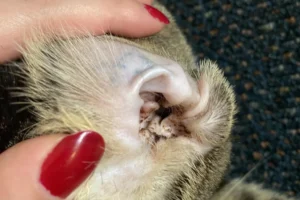Is your cat constantly licking and biting at their paws? Are they showing signs of discomfort and irritation? If you’re wondering why your cat’s paws are itchy, you’re not alone. Let’s explore the common reasons behind this behavior and how you can help your furry friend find relief.
Allergies: Understanding the Potential Culprits
Is your cat constantly licking and chewing at their paws? Allergies could be the culprit behind their discomfort. Food allergies are a common issue, with ingredients like beef, chicken, dairy, and grains often triggering reactions. Environmental allergens, such as pollen, mold, and dust mites, can also cause itchy paws. Additionally, contact dermatitis may occur if your furry friend is sensitive to certain materials like plastics, carpets, or cleaning products.
If you suspect allergies are to blame, consult your veterinarian for proper diagnosis and treatment. They may recommend an elimination diet to pinpoint food triggers or suggest allergy testing to identify environmental culprits. Addressing the root cause of your cat’s itchy paws is essential for their comfort and well-being.
Parasites: Could They Be the Problem?
When your cat’s paws are persistently itchy, parasites may be the sneakiest culprits. Fleas are a common annoyance, feeding on your cat’s blood and causing intense itching. Mites like ear mites or cheyletiella can also infest your cat’s paws, leading to irritation and scratching. Furthermore, ringworm, a fungal infection, can affect the paws, causing redness, itching, and hair loss.
To tackle these pesky parasites, regular flea prevention and grooming practices are crucial. Consult your vet if you suspect your cat has parasites to get the right treatment. Keeping your cat parasite-free is key to avoiding paw itchiness and ensuring they stay happy and healthy.
Skin Infections: Identifying and Treating the Issue
If your cat’s paws are constantly itchy, it could be due to skin infections caused by bacteria or fungi. Bacterial infections can result from injuries or scratches on the paw pads, leading to redness, swelling, and a foul odor. On the other hand, fungal infections like ringworm can also cause itchiness, along with crusty or scaly skin between the toes.
To identify these infections, look out for symptoms such as excessive licking or chewing of the paws, hair loss on the paw pads, or visible sores. If you suspect a skin infection, it’s essential to consult your veterinarian for a proper diagnosis and treatment plan.
Treatment for bacterial infections may involve topical antibiotics or oral medication, while antifungal creams or shampoos are commonly used to treat fungal infections. Keeping your cat’s paws clean and dry can also help prevent future infections.
Dry Skin: Moisturizing Solutions for Your Cat’s Paws
Dry skin is another common culprit for itchy paws in cats. Just like humans, cats can experience dryness on their paws, especially during colder months or in dry climates. Moisturizing your cat’s paws can help alleviate itchiness and discomfort.
To moisturize your cat’s paws, consider using pet-safe paw balms or moisturizing wipes specifically designed for cats. These products can provide hydration and protection for your cat’s delicate paw pads. Regular application can help maintain paw health and prevent dryness.
In addition to external moisturizers, ensure your cat stays hydrated by providing access to fresh water at all times. Proper nutrition with essential fatty acids can also help improve your cat’s skin health from the inside out.
Bonus Tip: When applying moisturizers to your cat’s paws, make sure to gently massage the product in for better absorption and to promote circulation. This can enhance the moisturizing benefits and soothe your cat’s itchy paws effectively.
Behavioral Issues: Examining Stress-Related Paw Licking
Is your cat constantly licking their paws, leading to itchiness? It could be a sign of stress, anxiety, or boredom. Cats, like humans, can exhibit behavioral issues through physical symptoms, such as excessive grooming. To help your feline friend, first try to identify any potential stress triggers in their environment. If there have been recent changes, such as a new pet or loud noises, try to create a calm and consistent atmosphere for your cat. Engaging them with interactive toys or puzzles can also provide mental stimulation and reduce anxiety. Additionally, consider consulting with a veterinarian or animal behaviorist for guidance on managing stress-related behaviors. Remember, a happy and relaxed cat is less likely to exhibit paw licking tendencies.
Grooming Habits: Promoting Healthy Paw Care
Maintaining your cat’s paw health is crucial in preventing itchiness and discomfort. Make it a routine to inspect your cat’s paws regularly for any cuts, foreign objects, or signs of irritation. Trim their nails to prevent overgrowth, which can lead to paw sensitivity and itchiness. Remember to provide a clean and comfortable litter box environment to prevent dirty paws. You can also enhance their paw care routine by applying a pet-safe moisturizer to keep their paw pads hydrated and supple. Additionally, encourage your cat to scratch on appropriate surfaces, like scratching posts, to help them naturally groom their claws. By prioritizing healthy grooming habits, you can ensure your cat’s paws remain itch-free and in optimal condition.
Tips for Healthy Paw Care:
- Regular Inspections: Check your cat’s paws weekly for any abnormalities.
- Proper Nail Trimming: Trim your cat’s nails every 2-3 weeks to maintain paw health.
- Clean Environment: Keep the litter box clean to prevent dirty paws and infections.
- Moisturize: Use a pet-safe paw moisturizer to prevent dryness and cracking.
- Scratching Posts: Provide appropriate scratching surfaces to promote natural grooming behaviors.
Remember, a little extra attention to your cat’s paw care routine can go a long way in ensuring their overall well-being and comfort.
Nutritional Factors: The Impact of Diet on Paw Health
Is your furry friend constantly chewing on their paws? It could be more than just a grooming habit. Nutritional deficiencies can play a significant role in causing itchy paws in cats. Ensure your cat’s diet is well-balanced and rich in essential nutrients like omega-3 fatty acids and vitamin E to support healthy skin and coat. Talk to your veterinarian about the best diet options for your cat to alleviate itchiness and promote overall paw health.
Additionally, food allergies can also manifest as itchy paws in cats. Switching to a hypoallergenic diet may help pinpoint and eliminate any potential allergens causing discomfort. Keep a close eye on your cat’s food intake and observe any changes in their paw condition to identify potential triggers.
Remember, what your cat eats plays a crucial role in their overall well-being, including their paw health. By ensuring they receive a balanced diet with essential nutrients, you can help them combat itchiness and maintain happy, healthy paws.
Pro tip: Consider incorporating oatmeal into your cat’s diet, as it can help soothe itchy paws due to its anti-inflammatory properties.
Veterinarian Visit: When to Seek Professional Help
If your cat’s paw itching persists despite your efforts to address it, it may be time to schedule a visit to the veterinarian. Persistent paw licking, redness, swelling, or the presence of sores can all be signs of an underlying issue that requires professional attention.
During the veterinary visit, your cat may undergo skin tests to identify any potential allergens or skin conditions causing the itchiness. Based on the diagnosis, your veterinarian will recommend an appropriate treatment plan to address the root cause of the problem, whether it’s allergies, parasites, or other skin issues.
Remember, early intervention and proper diagnosis are key to resolving your cat’s itchy paws effectively. Don’t hesitate to seek professional help if you notice persistent symptoms that don’t improve with at-home remedies. Your veterinarian is your best ally in keeping your feline companion healthy and happy.
Fun Fact: The Significance of Cat Paw Pads
Did you know that cat paw pads are not just adorable, but they serve a crucial purpose too? These paw pads are equipped with sensory receptors that help cats navigate their environment with ease. The pads are made up of thick layers of fatty tissue that provide cushioning and insulation, making them essential for a cat’s comfort and mobility. Next time you marvel at your feline friend’s paws, remember that those cute little pads are more than meets the eye!
When it comes to itchy cat paws, one common reason could be allergies. Cats can develop allergies to various substances like pollen, dust, or certain foods, which can cause irritation and itching on their paws. If you notice your cat excessively licking or biting their paws, it might be worth consulting your veterinarian to determine the allergen and provide relief for your furry companion. Addressing the underlying cause of the itching is crucial to ensure your cat’s comfort and well-being.
Explore interesting facts about cat paw pads and their unique structure.
Cat paw pads come in different colors based on the breed and can even change color depending on their mood or body temperature. These pads are not just cute little cushions; they are functional too, providing traction for climbing and hunting. Additionally, cat paw pads secrete sweat, which helps with thermoregulation and leaving their unique scent behind—a distinctive mark of their territory. So, the next time your cat’s paws are causing them discomfort, remember the complex and fascinating role these little pads play in their daily lives.
Remember, your cat’s paws are a precious part of their anatomy, so it’s important to keep them healthy and happy. If you notice your feline friend constantly scratching or licking their paws, it could be a sign of an underlying issue that needs attention. By understanding the significance of cat paw pads and their unique structure, you can better care for your cat and ensure they lead a comfortable and fulfilling life.
Alex, a passionate animal lover, has experience in training and understanding animal behavior. As a proud pet parent to two dogs and three cats, he founded AnimalReport.net to share insights from animal experts and expand his knowledge of the animal kingdom.









